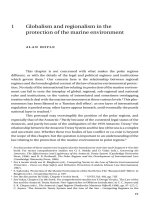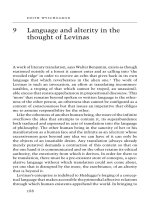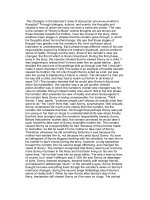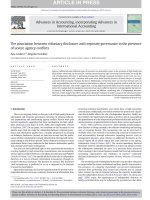Chinese businesses and changes in the thai retail sector
Bạn đang xem bản rút gọn của tài liệu. Xem và tải ngay bản đầy đủ của tài liệu tại đây (839.97 KB, 160 trang )
CHINESE BUSINESSES AND
CHANGES IN THE THAI RETAIL SECTOR
TRIN THANANUSAK
NATIONAL UNIVERSITY OF SINGAPORE
2010
CHINESE BUSINESSES AND
CHANGES IN THE THAI RETAIL SECTOR
TRIN THANANUSAK
st
(B.A. 1 Class Hons.) Chulalongkorn University
(Diploma in Computer Science) University of Cambridge
A THESIS SUBMITTED
FOR THE DEGREE OF MASTER OF SOCIAL SCIENCE
DEPARTMENT OF SOCIOLOGY
NATIONAL UNIVERSITY OF SINGAPORE
2010
ACKNOWLEDGEMENT
This thesis could only have been accomplished due the help and support from many
parties. First, I wish to express the deepest gratitude to my supervisor, Asst Prof. Misha
Petrovic, for guiding me throughout the research process, sharing his expertise on the
globalisation of retailing and theoretical perspectives, as well as giving me practical tips
for conducting research. Despite his tight schedule, he always welcomed me to openly
discuss about research, further study and careers in academia.
Furthermore, I am
grateful to my former supervisor, Assoc. Prof. Tong Chee Kiong, for teaching me how to
approach the research project and study at the NUS. This project went smoothly due to
his guidance. Moreover, I would like to thank the two thesis examiners who provided
valuable comments to enhance the thesis and advice for its publication.
With limited research experience, the training in Qualitative Data Analysis module
provided by Assoc. Prof. Maribeth Erb equipped me with essential skills, techniques and
confidence for the fieldwork and analysis. Dr Erb’s generosity and advice throughout
my NUS academic career are highly appreciated. Moreover, I would like to thank Prof.
Michael Hill and my research seminar classmates for suggesting the areas of
improvement area for my research plans. The advice from Prof. Stella Quah and the
DERC committee prepared me for the ethical concerns and enhanced the practicality of
my planned fieldwork. In addition, I am thankful to Ms. Hayati Bte Abdul for her
hospitality and help with the research materials, Ms. Raja and the Department’s
administrative office for their assistance.
i
I am heavily indebted to my two case studies and all informants in Thailand. During the
fieldwork, the two families treated me as if I were their family member; they shared their
valuable time to give insights into their retailing businesses, work ethics and family
values.
I am truly blessed to have support from my professors in Thailand. I am grateful for
Dr Chookiat Panaspornprasit’s continuous help and guidance since my undergraduate
years. The case studies were suggested by Dr Supamit Pitipat; he always provided sharp
and constructive criticisms to improve my analysis. I am also indebted to Dr Pavinee
Thirakupt and Dr Julian Lewis for their selfless devotion. Dr Pavinee helped read and
comment on the draft of my thesis even though she had many more urgent matters;
whilst Dr Julian helped proofread the revised thesis.
I would also like to thank
Dr Somboon Kulvisaechana, Dr Chaipong Pongpanich, Supakij Vicheanratanapong and
Nuttinee Angsakularporn, without whose help, I could not have accessed various
information about the Thai retail sector.
Finally, this thesis could not be achieved without the generous funding from the NUS
research scholarship and the Graduate Research Support Scheme of the Faculty of Arts
and Social Sciences. I would like to dedicate this thesis to my family, especially my
mother; she is the model of perseverance, optimism and consideration.
ii
iii
TABLE OF CONTENTS
ACKNOWLEDGEMENT .................................................................................................. i
TABLE OF CONTENTS ................................................................................................. iv
SUMMARY....................................................................................................................... x
LIST OF TABLES........................................................................................................... xii
LIST OF FIGURES ........................................................................................................ xiii
1. INTRODUCTION ....................................................................................................... 1
1.1
Problem Statement ............................................................................................. 1
1.2
Aim of the Study ................................................................................................ 3
1.3
Outline of the Thesis .......................................................................................... 5
2. BACKGROUND ......................................................................................................... 6
2.1
Chinese Businesses ............................................................................................ 6
Asian businesses: the context of Chinese businesses......................................... 6
Approaches to the study of Chinese businesses ................................................. 8
Characteristics of Chinese businesses .............................................................. 10
Guanxi………… .............................................................................................. 12
Future of Chinese businesses ........................................................................... 13
2.2
Dynamic Capabilities ....................................................................................... 15
Organisation Studies ........................................................................................ 16
Strategic Management ...................................................................................... 18
Key Perspectives in Strategic Management ..................................................... 19
Competitive forces or positioning views. ............................................ 19
Strategic conflict .................................................................................. 20
Resource-based views .......................................................................... 20
Dynamic capabilities ............................................................................ 21
iv
Dynamic capabilities and its recent developments .......................................... 21
Overview of Teece’s dynamic capabilities framework.................................... 22
Nature and microfoundations of dynamic capabilities .................................... 26
Sensing ............................................................................................................. 26
1. Nature of capability .......................................................................... 26
2. Microfoundations ............................................................................. 27
Seizing………………………………………………………………………...28
1 Nature of capability ........................................................................... 28
2. Microfoundations ............................................................................. 29
Managing threats and reconfiguration ............................................................. 30
1. Nature of capability .......................................................................... 30
2. Microfoundations ............................................................................. 30
2.3
Research Problem and Conceptual Framework ............................................... 31
Rationale for using dynamic capabilities framework ...................................... 33
3. RESEARCH DESIGN ............................................................................................... 35
3.1
Comparative Case Studies ............................................................................... 35
3.2
Research Procedures ........................................................................................ 38
Methods for collecting data.............................................................................. 38
Interviews ......................................................................................................... 38
Observation ...................................................................................................... 42
Documentary analysis ...................................................................................... 43
4. Globalisation of Retailing and the Thai Retail Industry ............................................ 44
4.1
Retail revolution ............................................................................................... 44
4.2
The internationalisation of retailing ................................................................. 47
4.3 Thai retail industry ........................................................................................... 49
The retail landscape between World War II and 1990..................................... 49
The dynamic retail landscape between 1990 and 2010.................................... 50
v
Grocery............................................................................................................. 53
Trend .................................................................................................... 55
Home building materials .................................................................................. 56
Trend .................................................................................................... 60
5. Case Studies: Background ......................................................................................... 61
5.1 Eternity ............................................................................................................. 61
The first generation (1946 – 1992): shophouse retailer ................................... 63
Competition .......................................................................................... 63
Strategy ................................................................................................ 64
Management and Organisation ............................................................ 64
The second generation (1992 – 2002): shopping mall ..................................... 65
The second generation: phase 1 (1992 -1996) ................................................. 65
Competition .......................................................................................... 66
Strategy ................................................................................................ 67
Management and Organisation ............................................................ 67
The second generation: phase 2 (1996- 2002). ................................................ 67
Competition .......................................................................................... 69
Strategy ................................................................................................ 69
Management and Organisation ............................................................ 69
The third generation: (2002 – present): modern trade store............................. 70
Competition .......................................................................................... 71
Strategy ................................................................................................ 71
Management and Organisation ............................................................ 71
5.2
Fortune ............................................................................................................. 72
The first generation: the first phase: setup (1983 – 1994) ............................... 75
Competition .......................................................................................... 75
Strategy ................................................................................................ 76
vi
Management and Organisation ............................................................ 77
The first generation: the second phase: the growth era (1994 – 2003) ............ 77
Competition .......................................................................................... 78
Strategy ................................................................................................ 78
Management and Organisation ............................................................ 79
The first Generation: the third phase: expansion and management transfer
(2003 to present). ................................................................................. 79
Competition .......................................................................................... 80
Strategy ................................................................................................ 81
Management and Organisation ............................................................ 82
6. Dynamic Capabilities................................................................................................. 84
6.1
Sensing ............................................................................................................. 84
1. Processes to identify target market segments, changing customer needs and
customer innovation. ............................................................................ 84
2. Processes to tap external innovation ............................................................ 86
3. Processes to direct internal R&D and select new technologies ................... 87
6.2
Seizing .............................................................................................................. 90
1. Delineating the customer solution and the business model ......................... 90
2. Selecting decision making protocols............................................................ 91
3. Selecting enterprise boundaries to manage complements and the control
platform ................................................................................................ 92
4. Building loyalty and commitment................................................................ 94
6.3
Managing threats and Reconfiguration ............................................................ 96
1. Decentralisation ........................................................................................... 97
2. Governance .................................................................................................. 99
3 Knowledge management ............................................................................. 100
7. The Evolution of Chinese Businesses...................................................................... 102
7.1
Paternalistic and centripetal control ............................................................... 102
vii
7.2
Informality ..................................................................................................... 106
7.3
Reliance on interpersonal relationships ......................................................... 109
7.4
Diversification ................................................................................................ 113
8. DISCUSSION .......................................................................................................... 115
8.1
Dynamic Capabilities ..................................................................................... 115
Key findings ................................................................................................... 115
Implications: ................................................................................................... 116
Agency in dynamic capabilities ......................................................... 116
Dynamic capabilities and survival. .................................................... 116
Dynamic capabilities: strengths and weaknesses of the framework .. 118
Dynamic capabilities and market making .......................................... 119
8.2
Chinese Businesses and Changes ................................................................... 120
Key findings ................................................................................................... 120
Implication: why some practices have changed and others not? ................... 122
The future of Chinese businesses ....................................................... 123
8.3
Limitation and Potential Areas for Research ................................................. 124
BIBLIOGRAPHY ......................................................................................................... 127
APPENDICES ............................................................................................................... 135
Appendix A: Debate, Developments and Critique of Dynamic Capabilities .......... 135
Debate in dynamic capabilities ...................................................................... 135
Nature ................................................................................................. 136
Effects ................................................................................................ 138
Recent developments ..................................................................................... 139
Critique........................................................................................................... 141
Appendix B: Table of Interviewees ......................................................................... 143
Eternity ........................................................................................................... 143
Fortune ........................................................................................................... 144
viii
ix
SUMMARY
This study investigated how Thai-Chinese family retailers have managed to survive
within the context of the rapid expansion of large foreign retailers since the mid-1990s, and how
the characteristics of Chinese businesses evolved. The findings showed that the two
case studies, Eternity and Fortune, in a north-eastern province of Thailand could adapt
their businesses to the changing ecosystem because both firms had dynamic capabilities
that allowed them to discern trends, capture opportunities by making the right
investment and reconfigure their assets.
Compared with Teece (2007)’s dynamic
capabilities model, the microfoundations of these firms were relatively informal.
Processes and procedures that undergirded the dynamic capabilities were not fully
rationalised and still embedded in the executives.
Eternity and Fortune evolved from small traditional Chinese family businesses to
professional firms. The changes were an attempt to improve the competitiveness of the
firms. The business owners still focused on only one business area of specialisation.
While the control was still in the hands of the owners, the practices such as the
paternalistic and centripetal control were not practical with the growing size of their
companies. Corporate governance was used in place of the traditional gongsi system to
prevent family conflicts. The attempt to decentralise and bring in professional managers
and lower staff was apparent. Both cases moved towards the increasing formality in
business operations.
The interpersonal relationship was still practised but it
progressively changed into professional relationships and weak ties. The strong ties
x
from the older management could be seen but both parties needed reciprocity to
strengthen the ties.
xi
LIST OF TABLES
Table 3-1: Data sources and objectives of the interviews ............................................... 40
Table 4-1: Key grocery retailers in each store type in Thailand...................................... 51
Table 4-2: Operators in the home building materials that operate as a modern trade store
......................................................................................................................................... 58
xii
LIST OF FIGURES
Figure 2-1: Dynamic capabilities framework of Teece (2007, figure 4:1342) ................ 23
Figure 2-2: The sensing microfoundation: Elements of an ecosystem framework for
“sensing” market and technological opportunities (Teece 2007, figure 1:1326) ............ 28
Figure 2-3: The seizing microfoundation: Strategic decision skills/execution (Teece
2007, figure 2:1334). ....................................................................................................... 29
Figure 2-4: The microfoundation for managing threats and reconfiguration:
Combination, reconfiguration, and asset protection skills (Teece 2007, figure 3: 1340) 31
Figure 4-1: The number of stores of Carrefour, Big C and Tesco from 1996 – 2009 ..... 55
Figure 5-1: Family tree of the Lee family, the owner of Eternity ................................... 61
Figure 5-2: Timeline of Eternity's business ..................................................................... 62
Figure 5-3: Family tree of the Koh family....................................................................... 73
Figure 5-4: Timeline of Fortune's business ..................................................................... 75
Figure 6-1: The notice notifying how to work with the purchasing unit of Fortune…..101
xiii
xiv
1. INTRODUCTION
In this chapter, I discuss the problem statement and the aim of the study, and then
describe the outline of the thesis.
1.1
Problem Statement
Since 1950, the global retail sector has been greatly transformed. Giant retailers such as
Walmart, Carrefour, Metro, Home Depot and IKEA, have consolidated the global retail
markets and this process has resulted in changes of practice and relationships between
suppliers, retailers and customers. The US retail formats such as supermarkets, big box
stores, supercentres, malls, and internet-based stores have diffused to many areas around
the world (Hamilton and Petrovic 2011).
Thailand also witnessed the effects of global retail transformation over the past two
decades.
After the 1997 financial crisis, the Thai government invited foreign
multinationals to resuscitate the economy. Rules and regulations were changed to attract
foreign investments because local entrepreneurs were weak and lacked capital
(Phongpaichit and Baker 2008). Thailand implemented a WTO agreement to liberate the
service sector which included the long-time protected retail industry.
The economic context was changed into a competition between foreign capital and
domestic capital (Phongpaichit and Baker 2008). There has been a significant increase
in the number of large international retailing stores, especially in the aftermath of the
1997 financial crisis. The meteoric expansion of global retailers such as Tesco (UK),
1
Carrefour (France) and Big C (Casino group, France) in Thailand led to the decline of
many local retailers. Tesco has grown from five branches in 1996 to 114 branches in
2009.
Intense competition drew complaints about unfair competition from foreign
operators.
This economic nationalism was invoked by local entrepreneurs to fight
foreign retailers.
The expansion of foreign stores to many parts of Thailand negatively affected local retail
operators who comprised mostly Thai-Chinese businesses. Some local stores were taken
over by foreign retailers whilst some ceased to operate (Kanchoochat 2008). Only a few
family-owned stores could turn around their businesses and compete against rival
foreign stores by adopting professional management and a modern trade model.
This change of business environments in the Thai retail sector led the government and
academics to focus on this issue. The Retail Act is being drafted to control the anticompetitive strategies of the large retail operators. Scholars provided studies and policy
options to create fair competition and reduce the impact on local and small retailers.
However, these studies tended to focus on macro level and the negative effects on
traditional retailers (c.f. Paopongsakorn and et al. 2002). There are limited empirical
micro-level studies that explain how the successful Thai-Chinese retailers adjusted
themselves and competed against the foreign stores.
Like other Southeast Asian countries, the leading local retailers in Thailand are mainly
Thai-Chinese (Butler and Hean 2000). Overseas Chinese have been an important engine
that has propelled the growth of economic activities in Southeast Asia (Hamilton 2006).
The Chinese have run their businesses based on Chinese values and traditions (Tsui and
2
Lau 2002); there are four main characteristics of Chinese businesses, namely
paternalistic control, informality, reliance on interpersonal networks and diversification
of businesses (Tong and Yong 1998; Hamilton 1996).
The low level of competition in the past partly contributed to the success of Chinese
entrepreneurs (Chan 2000). However, after the 1997 financial crisis, foreign operators
dramatically invested and competed in this region. To sustain their wealth, Chinese
businesses had to adjust their businesses to the new ecosystem (Tsui and Lau 2002:20;
Li and Tsui 2000). The question that arises is whether there will be a dominance of
Western business practices or a convergence between Western and Chinese practices.
Some scholars believed that Chinese firms would ultimately adopt the Western
management practice to increase their competitiveness (c.f. Landa 1983).
Others
contended that the Chinese values and practices will be continued but some Western
practices would be merged with the traditional practice of Chinese firms (c.f. Hamilton
2006; Yeung 2008).
1.2
Aim of the Study
The aim of this study is to investigate how the Thai-Chinese businesses in the retail
sector manage to survive in the changing context of the Thai economy during the past
two decades and how their characteristics of Chinese businesses evolve.
To examine how the Thai-Chinese retailers adjust themselves in the changing business
environments, the analysis of macro processes and determinants (retail globalisation and
Chineseness) is complimented with an organisation-level analysis --dynamic
3
capabilities. The dynamic capabilities approach is drawn from the strategic management
field which focuses on how firms create and maintain competitive advantage (Teece,
Pisano, and Shuen 1997). Dynamic capabilities are argued to help firms sustain their
competitiveness in the changing ecosystem.
These capabilities comprise three
capabilities –sensing, seizing and managing threats. That is, managers and business
owners must be able to sense the trend of new businesses from internal and external
sources and seize opportunities by investing and implementing a new business project at
the right time. Moreover, managers must be able to manage threats by continuously
realigning their assets with the emerging threats or opportunities (Teece 2007).
The dynamic capabilities’ model of Teece (2007) is used as the main framework of the
thesis to explain how Thai-Chinese retailers in Thailand have managed to survive in the
new competitive arena during the past two decades. Specifically, this study looks into
both organisational level capabilities and microfoundations (processes that support the
dynamic capabilities) that enable the Chinese retailers to sense and to capture business
opportunities, as well as to adjust themselves when the threats emerge (e.g. the
expansion of foreign retailers).
Regarding the contribution, firstly, this thesis applies the dynamic capabilities
framework
to
illuminate
the
evolution
of
Chinese
businesses
and
retail
internationalisation. This is an attempt to combine insights from strategic management
and Chinese business literature.
Secondly, this study explored to what extent the
dynamic capabilities approach could be applied to a non-technological industry such as
the retail industry. Thirdly, the findings of this thesis could explain how overseas
4
Chinese businesses with limited resources in the Asia Pacific region adapted and
competed in this globalised economic era. It could also shed light on the divergence and
convergence of Western and Chinese business practices.
Finally, the micro level
explanation of dynamic capabilities can supplement the previous macro study of the
transformation of the Thai retail industry by showing how the retailers developed and
executed their competitive strategy to compete with foreign retailers.
1.3 Outline of the Thesis
In Chapter two, I explore theoretical and empirical studies on the topic of Chinese
businesses and dynamic capabilities, and then elaborate upon the research questions and
conceptual framework of the thesis. Chapter three describes the comparative case study
method and research procedures. In Chapter four, the globalisation of retailing and the
retail industry in Thailand are analysed to provide the context of the transformation of
the Thai-Chinese retailers. Chapter five outlines the background and development of
two Thai-Chinese retailers during the past two decades. Chapter six examines how the
two cases have adjusted their businesses and managed their dynamic capabilities in the
changing environments.
Chapter seven investigates the changes in features of the
Chinese businesses. Finally, Chapter eight discusses the key findings and draws some
implications on the dynamic capabilities and the evolution of Chinese businesses.
5
2. BACKGROUND
This chapter discusses the theoretical developments and empirical studies that are
needed to understand how the Chinese businesses adapted their organisations in the
context of the changing business environments. I begin by discussing the context of
research in Chinese businesses, their main characteristics and the relevant debate in
section 2.1. Section 2.2 deals with dynamic capabilities which are used as the main
framework of this study to explain the features that enable firms to survive in dynamic
environments. Finally, section 2.3 elaborates the research questions and conceptual
framework of the thesis.
2.1
Chinese Businesses
Overseas Chinese have been a key economic actor that has driven the capitalist
development of the Southeast Asian region for centuries (Hamilton 2006). Chinese
values and traditions have influenced how the Chinese have managed their businesses
(Tsui and Lau 2002); however, in the context of globalisation, the convergence between
Chinese and Western management has also appeared to increase, hence, in order to
better understand the adaptation of the Chinese firms in the context of a globalised
economy, this section discusses the key literature regarding Chinese businesses.
Asian businesses: the context of Chinese businesses
Research interests in Asian businesses have grown since 1980 with the success of
businesses in this region. However, the research seems to be fragmented into each
6
discipline (such as management and political economy). Yeung (2007) discussed the
three strands of theoretical perspectives of the research in Asian business:
1) Research on Asian firms: This area focuses on the resource-linking ability within
firms and between organisational networks and business groups (keiretsu, chaebol and
Chinese conglomerates).
2) Institutions, states and business systems analysis: Researchers study the role of
“developmental states” in providing, directing and intervening in the development of key
economic sectors. The linkages between business groups and states are analysed. Social
and cultural institutions (e.g. role of guanxi as social institutions) are also explored to
account for the variety in performance of Asian businesses.
3) Global processes analysis: Global value chain and global production networks are
investigated to explain the influence of the global market on the adjustment of the Asian
businesses.
Concerning the potential research in Asian businesses, useful concepts from various
disciplines should be integrated. The studies should establish a linkage between the
micro and macro level. Institutional frameworks of Asian countries should be analysed
since the role of states and institutions are distinct from the West (Yeung 2007).
7
Approaches to the study of Chinese businesses
Within the context of Asian business studies, researchers pay significant attention to the
field of Chinese businesses. There are three major approaches to studying Chinese
businesses (Tong 2008).
1) Cultural approach:
This is based on the Confucian and post-Confucian hypothesis of the spirit of Chinese
capitalism (Redding 1990; Yao 2002).
The weakness of this approach is an
oversocialised view. It is unable to explain the variations in organisations which share
cultural beliefs (Hamilton and Biggart 1986)
2) Economic approach
This view claims that the economic rationality determines the organisational structure.
The organisational structure would evolve a common form in order to achieve efficiency
(Williamson 1985). Long and Han (2008) argued from the neo-institutional economic
perspective that the practices of the Chinese entrepreneurs in the past were influenced by
the lack of supporting institutions, rather than the cultural factors.
This approach,
however, cannot account for the various forms of organisations such as hybrid, hierarchy
or network firms (Powell 1990).
8
3) Institutional approach
This approach believes that the various forms of organisations arose due to historical
differences and the dynamics of businesses.
Hamilton (2006:10) pointed out that
institutions do not directly affect the outcome of economic activities. However, they
only provide frameworks to constrain and enable actors. In fact, capitalist economies are
driven from the rationality of actors within their economies. The economic interactions
in capitalist systems are focussed upon exercising control in order to maximise each
participant's interests. Organisational arrangement in the economies is only affected
indirectly by institutions or roles of states.
Furthermore, Hamilton suggested the combining of institutional analysis with
organisational dynamics and the use of comparative methods. For example, capitalism
should be studied in terms of several units (entrepreneurs, firms, money, products,
markets and industries) that interact with each other. Capitalism is dynamic through
time and space.
The interactions in economic activities could transcend national
boundaries since capitalism is a global phenomenon.
“Chinese capitalism” is another research attempt that tries to incorporate all the
explanations from these three approaches. “Chinese capitalism” refers to a “historically
and geographically specific form of economic organization that refers to the social
organization and political economy of the so-called “overseas Chinese” living outside
mainland China, particularly in East and Southeast Asia” (Yeung 2008:32). This type of
capitalism is not a distinct form because it is embedded in socioeconomic contexts.
Also, the characteristics of “Chinese capitalism” have continuously evolved.
9









